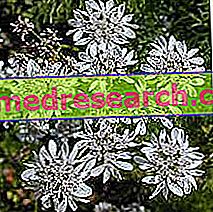
Scientific name
Ricinus communis
Family
Euphorbiaceae
Origin
Africa and tropical regions
Used Parts
The plant uses the oil extracted from the seeds, since in their entirety the seeds are toxic and deadly.
Chemical constituents
- Oil: ricinolein, which free glycerol and ricinoleic acid by hydrolysis;
- Seeds (peel): ricin and ricinine, two highly toxic glycoproteins.
Castor oil plant in herbal medicine: Ricino properties
Castor oil, which is cold extracted from seeds, was used as a powerful laxative (energetic purgative effect, toxic at high doses).
Ingestion of castor beans is toxic and can lead to death of the individual (nausea, vomiting, diarrhea, kidney failure up to shock).
Biological activity
As mentioned, castor oil is able to exert a marked laxative activity. This action is attributable to the ricinoleic acid it contains. This compound, in fact, is able to stimulate the water secretion of the small intestine, accelerating peristalsis and favoring the expulsion of the intestinal contents in the form of semi-liquid stools.
Furthermore, from a study conducted on animals, it was found that castor oil is also able to stimulate the synthesis of prostaglandins E2 in the small intestine.
However, the aforementioned oil is also endowed with a certain toxicity conferred by the ricinine and ricin contained in it.
At one time, castor oil was widely used as a laxative remedy, but currently its use has been abandoned due to its toxicity and due to the excessively drastic purgative action it exerts. In fact, the use of castor oil has not obtained official approval for any type of therapeutic indication.
Castor oil in folk medicine and homeopathy
The laxative properties of castor oil have long been known to folk medicine, which uses it precisely for the treatment of constipation, but not only. In fact, traditional medicine uses castor oil also as an internal remedy for inflammatory and intestinal parasites.
Externally, instead, castor oil is used by folk medicine as a remedy for skin inflammation, abscesses, boils, inflammations of the middle ear, headache and even for the treatment of carbuncle.
In Chinese medicine, castor oil is used to treat ailments such as sore throat, boils, ulcers, skin inflammation and facial paralysis.
In Indian medicine, instead, castor oil is used as a remedy to counter dyspeptic disorders and joint pains.
Castor oil is also used in homeopathic medicine, where it can be found in the form of granules and oral drops.
In this context the plant is used in case of diarrhea, gastroenteritis, colic, breast tenderness and illness.
The amount of homeopathic remedy to be taken may differ from individual to individual, also depending on the type of disorder that needs to be treated and according to the type of preparation and homeopathic dilution that is intended to be used.
Side effects
In rare cases, following the use of castor oil, the appearance of skin allergic reactions has occurred.
It is good to remember that the internal use of castor oil is generally not recommended due to the excessive laxative effect it is able to exert. In fact, in the event of taking too high doses of castor oil, serious side effects may occur such as nausea, vomiting, severe diarrhea, colic and loss of electrolytes (especially potassium ions). In particular, the latter side effect can also lead to very serious consequences.
Contraindications
Avoid ingesting castor oil in cases of proven hypersensitivity to one or more components and in patients suffering from enterocolitis, intestinal obstructions, inflammatory bowel diseases, appendicitis and / or abdominal pain of unknown origin.
Furthermore, the use of castor oil is also contraindicated in pregnancy, lactation and in children under 12 years of age.
Pharmacological Interactions
- enhancement of the pharmacological effect of cardioactive glycosides;
- it should not be taken with potentially toxic soluble anthelmintic oils, such as the male fern, because it increases absorption.



